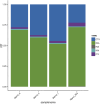Four new genome sequences of the Pallas's cat (Otocolobus manul): an insight into the patterns of within-species variability
- PMID: 39720181
- PMCID: PMC11667119
- DOI: 10.3389/fgene.2024.1463774
Four new genome sequences of the Pallas's cat (Otocolobus manul): an insight into the patterns of within-species variability
Abstract
Manul (Otocolobus manul) is the only representative of the genus Otocolobus, which makes up the Leopard Cat lineage along with the genus Prionailurus. Their habitat is characterized by harsh environmental conditions. Although their populations are probably more stable than previously thought, it is still the case that their population size is declining. Conservation programs exist to protect manuls, but those based on captive breeding are often unsuccessful due to their increased susceptibility to diseases. The manul is therefore a suitable model species for evolutionary and diversity studies as well as for studying mechanisms of adaptation to harsh environment and mechanisms of susceptibility to diseases. Recently, the genome of the O. manul based on nanopore long-range sequencing has been published. Aiming to better understand inter- and intraspecific variation of the species, we obtained information on genome sequences of four other manuls, based on whole genome resequencing via the Illumina platform. On average, we detected a total of 3,636,571 polymorphic variants. Information on different types of structural variants and on the extent of SNP homozygosity, not available from the reference genome, was retrieved. The average whole-genome heterozygosity was almost identical to that found in the O. manul reference genome. In this context, we performed a more detailed analysis of the candidate gene EPAS1 potentially related to adaptation to the hypoxic environment. This analysis revealed both inter- and intraspecific variation, confirmed the presence of a previously described non-synonymous substitution in exon 15 unique to manuls and identified three additional unique non-synonymous substitutions located in so far not analyzed EPAS1 exonic sequences. The analysis of lncRNA located in the intron 7 of EPAS1 revealed interspecific variability and monomorphic nature of the sequence among analyzed manuls. The data obtained will allow more detailed analyses of the manul genome, focusing on genes and pathways involved in their adaptation to the environment and in susceptibility to diseases. This information can be helpful for optimizing conservation programs for this understudied species.
Keywords: EPAS1; genome; manul; sequencing; variability.
Copyright © 2024 Bubenikova, Plasil, Burger and Horin.
Conflict of interest statement
The authors declare that the research was conducted in the absence of any commercial or financial relationships that could be construed as a potential conflict of interest
Figures
Similar articles
-
Chromosome-level, nanopore-only genome and allele-specific DNA methylation of Pallas's cat, Otocolobus manul.NAR Genom Bioinform. 2023 Apr 4;5(2):lqad033. doi: 10.1093/nargab/lqad033. eCollection 2023 Jun. NAR Genom Bioinform. 2023. PMID: 37025970 Free PMC article.
-
Dietary Differentiation Mitigates Interspecific Interference Competition Between Sympatric Pallas's Cats (Otocolobus manul) and Red Foxes (Vulpes vulpes).Animals (Basel). 2025 Apr 29;15(9):1267. doi: 10.3390/ani15091267. Animals (Basel). 2025. PMID: 40362082 Free PMC article.
-
Ecological niche models reveal divergent habitat use of Pallas's cat in the Eurasian cold steppes.Ecol Evol. 2022 Dec 14;12(12):e9624. doi: 10.1002/ece3.9624. eCollection 2022 Dec. Ecol Evol. 2022. PMID: 36532134 Free PMC article.
-
An intraerythrocytic small piroplasm in wild-caught Pallas's cats (Otocolobus manul) from Mongolia.J Wildl Dis. 2003 Apr;39(2):424-30. doi: 10.7589/0090-3558-39.2.424. J Wildl Dis. 2003. PMID: 12910772
-
Beyond trophic morphology: stable isotopes reveal ubiquitous versatility in marine turtle trophic ecology.Biol Rev Camb Philos Soc. 2019 Dec;94(6):1947-1973. doi: 10.1111/brv.12543. Epub 2019 Jul 24. Biol Rev Camb Philos Soc. 2019. PMID: 31338959 Free PMC article.
References
-
- Aylward M., Sagar V., Natesh M., Ramakrishnan U. (2022). How methodological changes have influenced our understanding of population structure in threatened species: insights from tiger populations across India. Philos. Trans. R. Soc. Lond B Biol. Sci. 377 (1852), 20200418. 10.1098/rstb.2020.0418 - DOI - PMC - PubMed
-
- Barclay D., Smelansky I., Nygren E., Antonevich A. (2019). Legal status, utilisation, management and conservation of manul. CATnews 2019 (13), 37–40.
LinkOut - more resources
Full Text Sources
Miscellaneous



